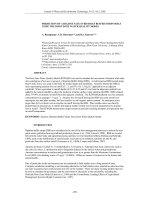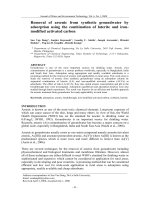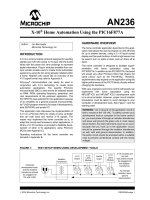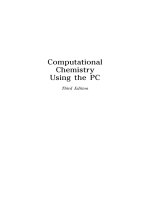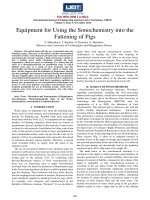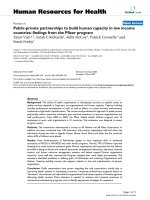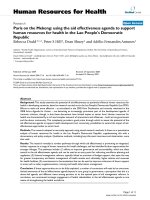Low latency BCH decoder using the affine polynomial over the finite field
Bạn đang xem bản rút gọn của tài liệu. Xem và tải ngay bản đầy đủ của tài liệu tại đây (408.21 KB, 9 trang )
Research
Low latency BCH decoder using the affine polynomial over the finite field
Pham Khac Hoan1*, Nguyen Tien Thai1, Vu Son Ha2
1
Military Technical Academy;
Academy of Military Science and Technology.
*
Corresponding author:
Received 10 Sep 2022; Revised 25 Nov 2022; Accepted 15 Dec 2022; Published 30 Dec 2022
DOI: />2
ABSTRACT
The paper proposes a low latency BCH decoder with low complexity using parallel
computation and simplifying locating errors by finding the roots of the affine polynomial over
finite fields. The proposed design can be implemented on low-cost hardware platforms while
applicable in very low latency information systems.
Keywords: Error-correcting code; finite field; affine polynomial; BCH code.
1. INTRODUCTION
Several problems are associated with solving equations over finite fields, such as error
correcting code that requires the key equation when decoding BCH, Reed-Solomon,
Goppa code, and decryption cryptosystems based on codes. Berlekamp is one of the
authors who has significantly contributed to solving the problem of factorization of
polynomial in finite fields [1].
Some indirect methods to solve equations over finite fields include: implementing
iterative algorithms such as Chien procedures and using Fourier transform in the Galois
field. However, these methods are often associated with relatively sizeable
computational delay and high complexity [2-4].
The BCH code is widely applied in digital information transmission, storage, and
processing systems such as optical communication systems, digital television, WBAN
information, flash memory protection, etc. The classical BCH coding methods use the
Belekamp-Massey algorithm to solve the key equation and the Chien procedure to find
the root of the error locator polynomial by checking all the elements of the field [5-7].
However, these methods have a significant processing delay and implementation
complexity, especially when a large field size. In some cases, when the number of errors
to be corrected is not too large, it is possible to use the direct method thanks to Peterson's
algorithm to calculate the error locator polynomial, thereby reducing the implementation
complexity of the decoder [4, 8].
Linearized polynomials and affine polynomials have several remarkable properties
that allow them to simplify finding roots. However, only a tiny number of polynomials
can be linearized and affine polynomials. Based on algebraic transformations and finding
the affine polynomial is a multiple of a given polynomial, roots of this polynomial can
be found among the roots of the affine polynomial [2, 8].
This paper investigates the method of decoding BCH based on combining the
Peterson algorithm to calculate the error locator polynomial coefficient and finding the
root of the error locator polynomial by finding the root of the affine polynomial, which is
a multiple of the polynomial whose roots need be found. The results obtained allow
application in different cases and can be extended to fields with arbitrary sizes. The
Journal of Military Science and Technology, Special issue No.6, 12- 2022
105
Computer science and Control engineering
proposed method reduces the complexity and processing delay of the decoder so that it
can be applied in the design of BCH encoder and decoder for low-latency information
systems such as WBAN, significant capacity memories, and optical communication
networks...The rest of the paper is organized as follows. Section II outlines the basics of
BCH codes and proposes a method of BCH decoding using Peterson's direct method for
finding error locator polynomials. Section III studies a particular class of polynomials
that are linearized in finite fields and proposes a 3-error correction decoding method
based on finding the roots of the affine polynomial. Section 4 presents comparisons and
analyses of the complexity and processing delay of the proposed method. Finally, some
conclusions are drawn.
2. OVERVIEW Of BCH CODES AND A DIRECT DECODING OF BCH CODES
2.1. BCH code and decoding algorithms
Let us consider a primitive binary BCH code in the narrow sense t-error-correcting
with length code n 2m 1.
*Algebraic methods for decoding BCH
Given r ( x) v( x) e x representing the polynomial from the received codeword, the
error polynomial is defined as:
e x e j1 x j1 e j2 x j2
e jv x jv
(1)
, e jv and j1 , j2 ,
where v t is the number of errors. The tuples e j1 , e j2 ,
, jv are the
error values and the error locators, ej {0, 1} for the binary BCH code and GF(2m).
The syndrome is the r(x) value at each zero of the code:
s1 r e j1 j1
s2 r 2 e j1 2 j1
s2t r 2t e j1
2 t j1
e jv x jv
e jv x 2 jv
e jv x
(2)
2 t jv
The error locator polynomial is defined as:
x 1 j 1 1 x 2 x 2
v
1
v xv
(3)
With the roots of the equation being the inverse of the error locations. The relationship
between the coefficients of and the syndrome [3-5]:
sv 1 v
sv 1 s1 s2
sv 2 v 1
sv 2 s2 s3
(4)
s2 v 1 1
s2 v sv sv 1
Solving the key equation (4) is the most challenging problem in the process of BCH
decoder. The popular methods for solving key equations are:
+ Berlekamp-Massey algorithm (BMA).
106 P. K. Hoan, N. T. Thai, V. S. Ha, “Low latency BCH decoder using the affine … the finite field.”
Research
+ Euclid algorithm (EA).
The Berlekamp – Massey algorithm (BMA) is efficient for solving key equations in
GF(2m). BMA is considered the least hardware complexity algorithm, using an iterative
procedure to construct a minimum-length linear shift feedback register structure, forming
a syndrome sequence s1 , s2 , , s2t .
The Euclidean Algorithm (EA) algorithm is widely used in the hardware
implementation of BCH decoders based on a recursive procedure to find the greatest
common divisor between two polynomials.
*Chien search and correct errors:
To find the roots of (x) a trial-and-error procedure is known as a Chien search. All
non-zero elements of GF(2m) in series 1, , 2, … are tried and conditionally tested
( 1 ) 0.
Thus, algebraic methods for decoding BCH require solving high-order key equations
over the Galois field. Iterative algorithms BMA, EA, and Chien search procedure have
considerable processing delay when n and t are large, which limits the application of
BCH code to low-latency information systems.
2.2. A direct method to decode BCH codes
In case the number of errors is not too large, Peterson's algorithm can be used to
determine the error locator polynomial coefficient as follows:
When correcting two errors:
0 S1 , 1 S12 , 2 S3 S13
(5)
When correcting for three errors to avoid inversion, all coefficients are multiplied by
S2 S13 :
0 S3 S13 , 1 S1S3 S14 , 2 S12 S3 S5 , 3 S13S3 (S3 S13 )2 S1S5
(6)
Below is an in-depth analysis and design of a binary BCH decoder that corrects three
errors. Algorithm 1 decodes the BCH code and corrects three errors as follows.
Algorithm 1.
Step 1: Calculate the syndrome S (S1 , S3 , S5 )
Step 2: Find the error locator polynomial
- If S1 S3 S5 0 , there are no errors.
- If D2 S3 S13 0 and S5 S15 0 , there is a single error.
- If S3 S13 0 or S5 S15 0 and A S13 S3 (S3 S13 )2 S1S5 0 , there are two
errors.
- If S3 S13 0 , S5 S15 0 , and A S13 S3 (S3 S13 )2 S1S5 0 , there are three
errors.
Step 3: Find the root of the error locator polynomial
- For single error, the error locator corresponds n log S1.
Journal of Military Science and Technology, Special issue No.6, 12- 2022
107
Computer science and Control engineering
- For two errors, error locator are inverses of roots of quadratic equations:
( x) 0 1 x 2 x2 0,
where the coefficients are determined according to (5).
- For three errors, error locators are inverses of solutions of the equation:
( x) 0 1 x 2 x2 3 x3 0,
where the coefficients are determined according to (6).
To avoid confusion with other cases, when there are three distinct roots, the error
Ax3 Bx2 Cx D,
locator
polynomial
has
the
form:
where
3
2
3 2
3
A S1 S3 (S3 S1 ) S1S5 , B S1 S3 S5 , C S3 S1 , D S1.
The pipeline circuit that determines the coefficients is described in figure 1.
S1
S3
S5
S1
C
B
()2
()2
S13
S12 S3
D
C
A
B
Figure 1. Circuit for calculating the coefficient of error locator polynomial.
- Step 4: Correct errors according to the error locations from the error locator.
3. DECODING THREE-ERROR BCH CODE BASED
ON THE ROOT OF THE AFFINE POLYNOMIAL
3.1. Construct an affine polynomial that is a multiple of the error locator
polynomial
In this section, only the case of three errors is considered (the key equation has three
different roots). When A 0 we can find multiple affine polynomials of the form:
A( z) ( Az 3 Bz 2 Cz D)( Az B) A2 z 4 ( AC B 2 ) z 2 ( BC AD) z BD
(7)
The roots of the equation A( z ) 0 are the roots of the equation:
L( z) A2 z 4 ( AC B2 ) z 2 ( BC AD) z BD
(8)
In the following, we consider the method of finding roots of affine polynomials and
linearized polynomials.
A polynomial L( z ), over GF( p m ), is said to be a linearized polynomial if
s
L( z ) Li z p , Li GF (2m ).
i
(9)
i 0
108 P. K. Hoan, N. T. Thai, V. S. Ha, “Low latency BCH decoder using the affine … the finite field.”
Research
Notation 0 , 1 ,..., m1 is the polynomial basis of the field GF( p m ) , and we have the
following proposition.
Proposition [2]
Let L( z ) be a linearized polynomial in GF( p m ) , and the element z is represented
z Z k k , Z k GF( p) then:
k
L( z ) Z k L( k )
(10)
k
m 1
When using the polynomial representation of the elements L( i ) Ci , j j . Thus,
j 0
the polynomial expansion coefficient L( z ) on the polynomial basis is calculated as
follows:
L0 , L1,..., Ln1 Z0 , Z1,..., Zn1 .C,
(11)
in which
C0,0
C
1,0
C
.
Cn 1,0
C0,1
C0,1
C1,1
C1,2
.
.
Cn 1,1 Cn 1,2
.
.
.
.
.
.
.
.
. C0,n 1
. C1, n 1
.
.
. Cn 1, n 1
(12)
Example 1
Finding roots of the polynomial f ( z) z 3 13 z 2 z 3 , with 4 1 0.
The least multiple affine of f ( z ) is the polynomial A( z ) 8 z 12 z 2 z 4 .
Finding roots of the polynomial A( z ) 8 z 12 z 2 z 4 . Consider the linearized
polynomial L( z) 8 z 12 z 2 z 4 .
First, we calculate the values:
L(1) 8 12 1 1 3 ;
L( ) 9 14 4 0;
L( 2 ) 10 16 8 0;
L( 3 ) 11 18 12 1 3 .
From which, we can find the roots of the equation L( z ) by solving the system
of equations:
1
0
Z0 , Z1 , Z 2 , Z3
0
1
1
0
0
0
0
0
0
0
1
0
0100.
0
1
The above system of equations has roots Z 1011 13 ; Z 1111 12 . These
are the two roots over GF(24 ) , in which 12 is the root of f ( z ). It can be factorized in:
Journal of Military Science and Technology, Special issue No.6, 12- 2022
109
Computer science and Control engineering
f ( z) z 3 13 z 2 z 3 ( z 12 )( z 2 z 6 ).
Carrying out finding the roots of the polynomial z 2 z 6 , we have two roots
7 , 14 .
3.2. Solve a system of linear equations over the field GF(2m)
The author has presented an effective way to solve the system of linear equations of
the form (11) in [3]. This method uses linear transformations on columns to get a
triangular idempotent matrix.
Consider a system of linear equations in a finite field of the form:
L0,1 ... L0,m1
L0,0
L
L1,1 ... L1,m1
1,0
(13)
0, 0,..., 0.
Z0 , Z1 ,..., Z m1 ...
...
...
...
Lm1,0 Lm1,1 ... Lm1,m1
Using linear transformations on columns (exchanging, adding, subtracting columns
with multiplicating by coefficients) and upward rotating rows can transform a matrix to a
triangular idempotent form L.
Definition: A matrix L of dimensions m x m is in the reduced triangular idempotent
form if the elements below the main diagonal are zero, and the elements on the main
diagonal are zero or one. At the same time, if an element on the main diagonal is zero,
then the elements on the same column will be zero. If an element on the main diagonal is
one, then the elements on the same row will be zero.
For example, the matrix over GF(5) has a triangular idempotent form.
0
0
0
0
0
0
2 4 0 3 1
1 0 0 0 0
0 1 0 0 0
0 0 0 2 3
0 0 0 1 0
0 0 0 0 1
2
Note that L L from this, it follows that Z is the root of the equation Z L 0 if Z is
a linear combination of the rows of the matrix L I where I is a unit matrix of order m.
The algorithm to reduce a binary matrix to a triangular idempotent form is as follows.
Algorithm 2 [2]
1. If the top element of the leftmost column is one, do nothing. If this element is zero,
exchange that column with the leftmost column whose top element is one and whose
main diagonal element on that column is zero. If no such column can be found, then
exchange the leftmost column with the leftmost column whose top element is one and
whose main diagonal element is one. If such a column still cannot be found (the top row
is all zero), do nothing.
2. Zero the top element of each column except the leftmost column by subtracting
columns from the leftmost column.
110 P. K. Hoan, N. T. Thai, V. S. Ha, “Low latency BCH decoder using the affine … the finite field.”
Research
3. Rotate rows upward and rotate columns leftward.
In many cases, it is necessary to solve a system of linear equations of the form:
L
ZL U we will transform it into the form: Z , 1 0. By transformations on
U
columns (algorithm 2), the matrix L is transformed into a triangular idempotent form L ,
and the vector U is correspondingly transformed to the form U . Then we construct the
matrix L I . Carrying out the test U L I 0 then U is a root (all the products of
each component of U with the main diagonal components L I are zero). The remaining
roots are linear combinations of the non-zero rows of the matrix L I .
4. ANALYSIS OF THE COMPLEXITY OF
THE PROPOSED BCH ENCODING ALGORITHM
To evaluate the complexity of the proposed algorithm, we pay attention to some of the
following characteristics. Calculating the syndrome and the error correction circuit is
quite simple, and for all algebraic methods of BCH decoding these steps are performed
so that the comparison process can skip these steps. On the other hand, the complexity of
addition and multiplication depends on the implementation technique. The complexity of
addition is much lower than square and multiplication, and the complexity of inverse is
much larger than multiplication. We omit the addition (XOR) operations for simplicity
and consider the most commonly used implementation techniques [9-11]. Here we study
steps with considerable complexity.
In figure 1, in the case of three errors, it is necessary to use two squares and four
multiplications to determine the error locator polynomial. Moreover, the operations are
pipelined, and the computation delay is:
Tlp1 TSQ 2TMUL TXOR
where TSQ , TMUL , TXOR is the latency of squarer, multiplier, XOR, respectively.
Note that to implement a bit-parallel Montgomery squarer needs only m/2 XOR gates.
The time delay for this Montgomery squarer is equivalent to the delay of one XOR gate [11].
Meanwhile, if using the BMA algorithm with parallel architecture (considered to have
lower complexity than EA and other algorithms), to correct t errors, it is necessary to use one
inverse and 2t multiplications, for t = 3 requires six multiplications and one inverse.
Assuming the most efficient multiplier (Mastrovito multiplier) is used, the delay of the
multiplication TMUL AND log 2 m XOR , thus, processing delay of BMA algorithm is [12]:
Tlp 2 t (2 log 2 m) AND t log 2 m XOR tm OR ,
in which AND , OR and XOR is the computation time of AND, OR, and XOR, respectively.
With the step of finding the root of the error locator polynomial, the comparison of
the complexity and delay is as follows. First, to calculate the coefficients of the affine
polynomial A( z ) , it is necessary to use four multiplications and two square operations,
which can be performed in parallel in period TMUL . Note that with the method of solving
Journal of Military Science and Technology, Special issue No.6, 12- 2022
111
Computer science and Control engineering
a system of linear equations, the highest-complexity step is computing the values of
L( i ), i 0,1,..., m 1. In the case of t = 3, calculating each value
L( i ), i 0,1,..., m 1 requires two sequential square operations (to calculate z 4 ) and
two multiplications. Algorithm 2 to find roots of the system of equations has negligible
complexity because using only column shifts and permutations, and the implementation
delay is 3m clocks (independent of t). Thus, the delay in finding the error location
according to the proposed method increases mainly because of solving the system of
equations based on algorithm 2. This delay is paying the price for a significant reduction
in complexity.
When using the Chien procedure to find the root of the error locator polynomial, it is
necessary to compute the polynomial ( i ), i 1,..., n and check if it is zero. Each
calculation ( i ) needs to use t multiplications. When all calculations are performed in
parallel, the delay will be minimal. Then the processing delay can be estimated as
follows [12]:
TChien log 2 m XOR log 2 m AND
When m is large, the bit-parallel computation ( i ) becomes too complex, so use a
bit-serial multiplier to reduce the complexity. Then the Chien procedure needs n.m
clocks to complete the error locations.
Table 1. Comparison of complexity when correcting three errors
of the proposed method and the traditional methods.
Square Multiplication Inverse
The proposed method of finding the error locator
2
4
0
polynomial
Finding the error locator polynomial based on BMA
0
6
1
The proposed method of finding the error locations
2+2m
4+2m
0
Finding error locations based on Chien search
0
3n
0
Note that with a polynomial basis, the complexity of the multiplier is about m2 / 2
XOR gates, while that of the squarer is about XOR 2m OR gates [10]. Hence, the square
operation is much simpler than the multiplication. Thus, the proposed method has a
significantly reduced complexity and no inverse (complexity of inverse is O(m3)).
Table 2. Comparison of processing delay when correcting three errors of the proposed
method and the traditional method when performing parallelly bit processing.
Processing
Finding the error
Finding error location
Total delay
delay
polynomial
The
Tlp1 2 AND
Te 3 AND
T1 5 AND
proposed
(2 3m 3 log 2 m ) XOR (4 3m 2 log 2 m ) XOR
2(1 log 2 m ) XOR
method
The
Tlp 2 3(2 log 2 m ) AND TChien log 2 m XOR
traditional
log m
method 3 log 2 m XOR 3m OR 2 AND
T2 (6 4 log 2 m ) AND
(3m 4 log 2 m ) XOR
112 P. K. Hoan, N. T. Thai, V. S. Ha, “Low latency BCH decoder using the affine … the finite field.”
Research
5. CONCLUSIONS
The paper proposes a method to decode BCH using the Peterson algorithm to directly
calculate the error locator polynomial and find the error location by finding the roots of
an affine polynomial, which is a multiple of the error locator polynomial. The analytical
results show that the proposed method has a low complexity with a significantly reduced
number of multiplication operations by replacing multiplication with square and without
performing the inverse. And the total delay is also decreased considerably. Especially
when the field size is larger, the method's efficiency is more remarkable. In addition, the
proposed method for finding the root of the error locator polynomial can be extended to
higher multiple error correction cases where the total delay gain compared to the
traditional method will increase more. The proposed method allows the fabrication of
decoders with low complexity and latency, which opens the possibility of application in
low latency communication systems with few resources.
REFERENCES
[1]. Bijan Ansari, “Finite field arithmetic and its application in cryptography,” Dissertation for
the degree Doctor of Philosophy in Electrical Engineering, University of California, Los
Angeles (2012).
[2]. Elwyn R. Berlekamp, “Algebraic Coding Theory (Revised Edition),” World Scientific
Publishing Co. Pte. Ltd. (2015).
[3]. F. J. MacWilliams, N. J. A. Sloane, “The theory of error correction codes,” Elselvier (1977).
[4]. Tood K. Moon, “Error correction coding: Mathematical methods and algorithms,” John &
sons, Inc. (2005).
[5]. K. Deerganghao, “Channel coding technique for wireless communications,” Springer, (2015).
[6]. Fedorenko S. V., Trifonov P. V. “Finding roots of polynomials over finite fields,” IEEE
Transactions on Communications, Vol. 50, Issue 11, pp. 1709–1711, (2002).
[7]. J. Fredenberger, “A configurable Bose Chauhuri Hocquenghem codec architecture for flash
controller applications,” Journal of circuits, systems and computer, Vol. 23, No. 02, (2013).
[8]. J. Fredenberger, B. N. Bailon, M. Shafies, “Reduced complexity hard and soft decoding of
BCH codes with application in concatenated codes,” EIT circuit, devices and systems, pp.
284-296, (2021).
[9]. Johann Groβschadl, “A low-power bit serial multiplier for finite fields GF(2m),” 34th IEEE
International symposium on ciruits and system, vol. IV, pp. 37-40, (2001).
[10].H. Wu, “Montrogomery multiplier and squarer in GF(2m)” Lecture notes in computer
science, (2000).
[11].Lin Shu, Costello, Daniel J., “Error correcting codes,” Prentice-Hall, Inc. (2004).
[12].D. Strukov, “The area and latency tradeoffs of binary bit-parallel BCH decoders for
prospective nano electronic memories,” ACSSC Papers, (2007).
TÓM TẮT
Bộ giải mã mã BCH độ trễ thấp sử dụng tính chất
của đa thức affine trên trường hữu hạn
Bài báo đề xuất thiết kế bộ giải mã mã BCH có độ phức tạp và độ trễ thấp nhờ
thực hiện tính tốn song song và đơn giản hóa việc tìm vị trí lỗi nhờ tìm nghiệm
của đa thức affine trên trường hữu hạn. Thiết kế đã đề xuất có thể thực thi trên các
nền tảng phần cứng giá thành thấp đồng thời cho phép ứng dụng trong các hệ
thống thơng tin có độ trễ rất thấp.
Từ khố: Mã hóa sửa lỗi; Trường hữu hạn; Đa thức affine; Mã BCH.
Journal of Military Science and Technology, Special issue No.6, 12- 2022
113
